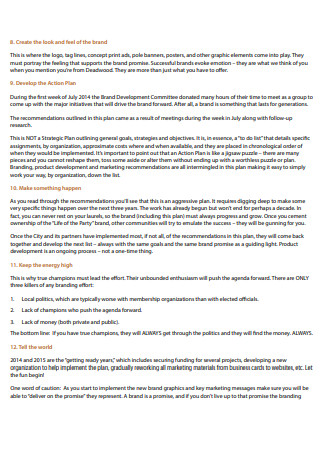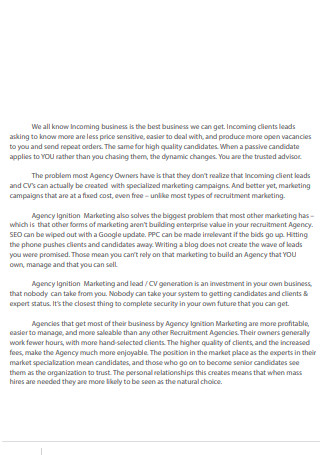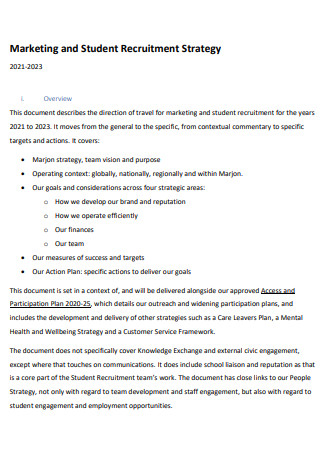3+ SAMPLE Recruitment Marketing Action Plan
FREE Recruitment Marketing Action Plan s to Download
3+ SAMPLE Recruitment Marketing Action Plan
What IS a Recruitment Marketing Action Plan?
Recruitment Marketing Strategy Mix
FAQs
Coming Up with a Recruitment Marketing Action Plan
FAQs
What are some of the benefits of having a recruitment marketing action plan?
What are some important factors to consider when hiring or recruiting for job openings?
What are some of the recruitment methods?
They have got the upper hand, with jobs being more abundant and all the offers coming in. Especially for candidates with a strong work experience background, they’ve probably been twice over courted by the same company, trying to meet their compensation and benefits expectations. Or even those who are still employed and being lured by other companies. Their current employers are looking for ways to offer more just to get them to stay on. So, if you’re a recruiter in this undoubtedly very competitive environment, you need to have an action plan to meet your own goals. You need to have a working and effective recruitment plan, a Recruitment Marketing Action Plan.
What IS a Recruitment Marketing Action Plan?
Like every other industry, the recruitment business industry has its own set of targets to hurdle. That is, finding the right candidate to fit in a vacant position, completing the recruitment process within a given period, and in some cases, hiring as many as they can. This is where a recruitment marketing action plan comes in.
It is a strategic, proactive approach to get the company that you’re representing out there, in the employment space, and to make the company as visible and as attractive as possible to potential top job candidates. The recruitment marketing action plan is a document that contains steps to reach out to your target candidates and eventually turn them into signed-up employees! How to do that? Well, read on.
Recruitment Marketing Strategy Mix
With the competition as wide as the job market, as a recruiter, you should have some well-thought-of tricks to up your recruiting ante game. One of the best ways to do so is to make sure that your strategies adhere to a SMART goal method. Meaning, your strategies should be Specific, Measurable, Achievable, Relevant, and Time-bound. Especially relevant. Even though the time-old traditional ways of recruiting still work, the best way of going after your job candidates is to use recruitment channels or media where they are highly interested and actively engaging. Or at least, channels that immediately catch their attention. In this read, we’ve come up with some recruitment marketing strategy tips that could help you and your recruitment team catch those ideal candidates – that is, before that other recruitment agency does!
FAQs
Coming Up with a Recruitment Marketing Action Plan
Having a recruitment marketing action plan is proof that a company, a recruitment agency, or a talent acquisitions team is not just about all talk, but about actions as well. The action plan contains a series of steps taken to strategically position the company as the best employer there is. After all, that’s how recruiters send out the message to potential candidates: work for this company, and we promise you the working compensation and benefits that you’ve always wanted.
There’s always that haggling, of course, over salary rates and everything else in between. But that’s another story. The ultimate purpose of having a documented action plan is that you have a guide at the end of the day that pinpoints to you what you should do and what not to do when it comes to marketing recruitment strategies. Although there’s no strict format when it comes to creating a recruitment marketing action plan, still, to make it effective, the action plan should at least contain the following essential elements.
-
1. Executive Summary
Recruitment is an essential part of any kind of business trade. And in every business planning, recruiting good talents is always part of a business’s operation. The executive summary section explains the kind of the purpose of the company. It first gives an overview of what the company is all about, its operations, its products, goods, and services. Then it delves into the mission and vision of the recruitment marketing action plan or the goals and objectives of the action plan. Executive summaries oftentimes contain a mission and a vision statement. A mission statement states the reason or purpose of the business, in this case, for the action plan. A vision statement describes what the business hopes to achieve out of its recruitment action plan, usually in a given time frame.
-
2. Market Analysis
Successful recruitment agencies, or recruiters, don’t just dive into recruiting without understanding their target market. That is what a market analysis is all about. A marketing analysis takes a look at the current market trend when it comes to job employment, hiring, and qualified candidates. It also checks and looks into the profile of competing hiring agencies and their hiring process. More often, the purpose of a market analysis is to research the profile of the target market potential candidates, looking into its demographics. Doing a demographics classification is particularly helpful when you’re creating advertisements so that you’ll know how to attract and capture your target audience’s attention. Doing a SWOT analysis could also help the recruitment team understand where the hiring company stands in the current market. SWOT stands for Strengths, Weaknesses, Opportunities, and Threats aspects of the hiring company. Strengths are what features of the hiring company stand out from other competing businesses. Weaknesses are those factors that limit a business’s success, or areas of a business that need further support. Opportunities are those factors that the company can leverage to boost its success, especially in terms of employment. And threats are those factors that could potentially harm or put at risk the business’s operation, especially when it comes to hiring.
-
3. Action Plans
Action plans are akin to market strategies. It’s all about positioning the hiring company in the right way. Action plans are created based upon goals and objectives and are time-bound. We have mentioned above some examples of recruiting marketing strategies that are very much effective and relevant in today’s market. In this section of the recruitment marketing action plans, each step is carefully itemized along with a deadline as to when the recruitment and hiring process should be completed. Businesses rely on how fast recruiters fill in vacant positions because, after all, those vacancies represent an integral part of a business’s operation, hence, the deadline should be set.
-
4. Monitor Recruitment Progress
To know if the recruitment marketing strategies are effective is to track and monitor its progress based on the given deadline. Tracking could be done on a daily, weekly, or monthly basis. Doing a tally of how many candidates have signed up for a job offer is a good start. If you’ve monitored that you’re still far from meeting the number of signed-up job candidates, then you need to make some revisions to your action plan and implement some more aggressive strategies. After all, at the end of the day, recruitment is also all about numbers.
FAQs
What are some of the benefits of having a recruitment marketing action plan?
More than just a roadmap of dos and don’ts when it comes to recruitment strategies, a recruitment marketing action plan sets the tone of urgency to accomplish the goals and objectives of the recruiting team, which are: to recruit and hire the right candidates for the right positions, and to recruit them at the soonest possible time. Another benefit is it identifies market strategies that allow the company to position itself appropriately and aggressively within the job market. Another is that it can enable proper planning on how to specifically target the right candidates for the vacant positions.
What are some important factors to consider when hiring or recruiting for job openings?
As a recruiter, you cannot just hire any random John Doe you come across. There’s a deeper thought process that goes into selecting the right candidates. Some of the factors that need to be considered when selecting the right candidate are educational background; work experience; personality and characteristics traits, if suitable for the job at hand; self-confidence; and/or specific skill set needed for the job.
What are some of the recruitment methods?
Recruitment methods vary from company to company, and from skill qualifications to job requirements. Recruitment methods over the years have to keep up with the times and be innovative when it comes to the search and selection process. Some of the popular recruitment methods being used are direct advertising (posting through social media, career sites, news media, publications, et cetera); talent pool database (where previous applicants who were not hired are kept on file, and whose records are pulled up when new positions are open); referrals, both internal or external; and/or through acquisition via internships or apprenticeships.
You have probably seen a lot of recruitment for-hire actions going through your social media feeds. Oftentimes, the appearances of these posts become all too many that it becomes a bit irksome at some point. But there are also times because of the way they created their recruitment ads that it appeared so enticing to a reader that you click on the banner ad link, leading you on to the website that’s telling you all about the job that made you think twice about your current job. Just the act of clicking on that ad shows how effective the recruitment marketing action plan was if it was able to get your interest and lead you through the next site!
Want to find out more about how to do that? Download our recruitment marketing action plan templates, and start planning your way towards a successful recruitment activity!




